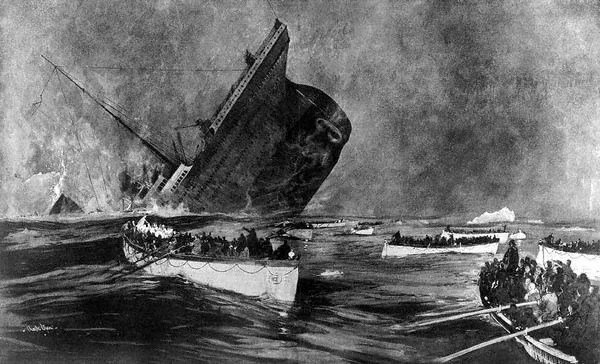Notice!
Travellers intending to embark on the Atlantic voyage are reminded that a state of war exists between Germany and her allies and Great Britain and her allies; that the zone of war includes the waters adjacent to the British Isles; that, in accordance with formal notice given by the Imperial German Government, vessels flying the flag of Great Britain, or any of her allies, are liable to destruction in those waters and that travellers sailing in the war zone on the ships of Great Britain or her allies do so at their own risk.
Imperial German Embassy
Washington, D.C., 22 April 1915.
On 17 April 1915, Lusitania left Liverpool on her 201st transatlantic voyage, arriving in New York on 24 April. A group of German-Americans, hoping to avoid controversy if Lusitania were attacked by a U-boat, discussed their concerns with a representative of the German Embassy. The embassy decided to warn passengers before her next crossing not to sail aboard Lusitania. The Imperial German Embassy placed a warning advertisement (above) in 50 American newspapers, including those in New York.
Lusitania was indeed officially listed as an auxiliary war ship, and her cargo had included an estimated 4,200,000 rounds of rifle cartridges, 1,250 empty shell cases, and 18 cases of non-explosive fuses, which was openly listed as such in her cargo manifest. The day after the sinking, The New York Times published full details of the ship’s military cargo. Assistant Manager of the Cunard Line, Herman Winter, denied the charge that she carried munitions, but admitted that she was carrying small-arms ammunition, and that she had been carrying such ammunition for years. The fact that Lusitania had been carrying shells and cartridges was not made known to the British public at the time.
Sinking of the RMS Lusitania
On 7 May 1915 Lusitania was nearing the end of her 202nd crossing, bound for Liverpool from New York, and was scheduled to dock at the Prince’s Landing Stage later that afternoon. Aboard her were 1,266 passengers and a crew of 696, which combined totaled to 1,962 people. She was running parallel to the south coast of Ireland, and was roughly 11 miles off the Old Head of Kinsale when the liner crossed in front of U-20 at 14:10. Because of the liner’s great speed, some believe the intersection of the German U-boat and the liner to be coincidence, as U-20 could hardly have caught the fast vessel otherwise. However, there are discrepancies concerning the speed of the Lusitania, as it had been reported traveling not near its full speed. Walther Schwieger, the commanding officer of the U-boat, gave the order to fire one torpedo, which struck Lusitania on the starboard bow, just beneath the wheelhouse. Moments later, a second explosion erupted from within Lusitania’s hull where the torpedo had struck, and the ship began to founder in a much more rapid procession, with a prominent list to starboard.
Almost immediately, the crew scrambled to launch the lifeboats but the conditions of the sinking made their usage extremely difficult, and in some cases impossible due to the ship’s severe list. In all, only six out of 48 lifeboats were launched successfully, with several more overturning and breaking apart. Eighteen minutes after the torpedo struck, the bow struck the seabed while the stern was still above the surface, and finally it slid beneath the waves.
Of the 1,962 passengers and crew aboard Lusitania at the time of the sinking, 1,191 lost their lives. As in the sinking of Titanic, most of the casualties were from drowning or hypothermia. In the hours after the sinking, acts of heroism amongst both the survivors of the sinking and the Irish rescuers who had heard word of Lusitania‘s distress signals brought the survivor count to 764, three of whom later died from injuries sustained during the sinking.
A British cruiser HMS Juno, which had heard of the sinking only a short time after Lusitania was struck, left her anchorage in Cork Harbour to render assistance. Just south of Roche’s Point at the mouth of the harbour only an hour from the site of the sinking she turned and returned to her mooring as a result, it is believed, on orders issued from admiralty house, Cobh (HQ Haulbowline naval base).
By the following morning, news of the disaster had spread around the world. While most of those lost in the sinking were either British or Canadians, the loss of 128 Americans in the disaster, including writer and publisher Elbert Hubbard, theatrical producer Charles Frohman, multi-millionaire businessman Alfred Vanderbilt, and the president of Newport News Shipbuilding, Albert L. Hopkins, outraged many in the United States.
Dublin-based technical diver Des Quigley, who dived on the wreck in the 1990s, has reported that the wreck is “like Swiss cheese” and the seabed around her “is littered with unexploded hedgehog mines”.
In February 2009, the Discovery Channel television series Treasure Quest aired an episode titled “Lusitania Revealed”, in which Gregg Bemis and a team of shipwreck experts explore the wreck via a remote control unmanned submersible. At one point in the documentary an unexploded depth charge was found in the wreckage, in plain sight, clearly seen by the remote control submersible’s video camera.
The Wreck
The wreck of Lusitania lies on its starboard side at an approximately 30-degree angle in roughly 300 feet (91 m) of water, 11 miles (18 km) south of the lighthouse at Kinsale. The wreck is badly collapsed onto her starboard side, due to the force with which she struck the bottom coupled with the forces of winter tides and corrosion in the decades since the sinking. The keel has an “unusual curvature” which may be related to a lack of strength from the loss of its superstructure. The beam is reduced with the funnels missing presumably to deterioration. The bow is the most prominent portion of the wreck with the stern damaged by depth charges. Three of the four propellers were removed by Oceaneering International in 1982. Expeditions to Lusitania have shown that the ship has deteriorated much faster than Titanic has, being in a depth of 305 feet (93 m) of water. When contrasted with her contemporary, Titanic (resting at a depth of 12,000 feet (3,700 m)), Lusitania appears in a much more deteriorated state due to the presence of fishing nets lying on the wreckage, the blasting of the wreck with depth charges and multiple salvage operations. As a result, the wreck is unstable and may at some point completely collapse.
In 2014 a release of papers revealed that in 1982 the British government warned divers of the presence of explosives on board:
Successive British governments have always maintained that there was no munitions on board the Lusitania (and that the Germans were therefore in the wrong to claim to the contrary as an excuse for sinking the ship) … The facts are that there is a large amount of ammunition in the wreck, some of which is highly dangerous. The Treasury have decided that they must inform the salvage company of this fact in the interests of the safety of all concerned.
The joint American-German production, The Sinking of the Lusitania: Terror at Sea premiered on the Discovery Channel on 13 May 2007, and on BBC One in the UK on 27 May 2007.
https://youtu.be/UiVDOVWgo-M








Leave A Comment